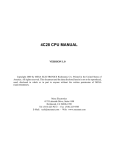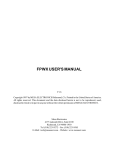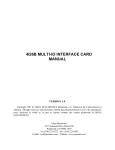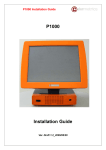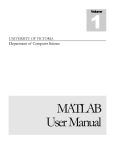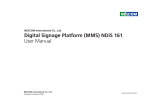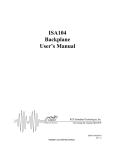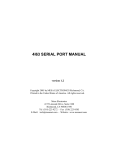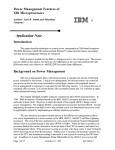Download 4C24 CPU MANUAL - Mesa Electronics
Transcript
4C24 CPU MANUAL VERSION 1.5 Copyright 1997 by MESA ELECTRONICS Richmoond, CA. Printed in the United States of America. All rights reserved. This document and the data disclosed herein is not to be reproduced, used, disclosed in whole or in part to anyone without the written permission of MESA ELECTRONICS. Mesa Electronics 4175 Lakeside Drive, Suite #100 Richmond, CA 94806-1950 Tel (510) 223-9272 - Fax (510) 223-9585 E-Mail: [email protected] - Website: www.mesanet.com 4C24 CPU USER'S MANUAL TABLE OF CONTENTS HANDLING PRECAUTIONS Lithium cell . . . . . . . . . . . . . . . . . . . . . . . . . . . . . . . . . . . . . . . . . . . . . . . . . . . . . . . . . . . . . . . . . . . . . . . . . . . . 6 Static electricity . . . . . . . . . . . . . . . . . . . . . . . . . . . . . . . . . . . . . . . . . . . . . . . . . . . . . . . . . . . . . . . . . . . . . . . . 6 INTRODUCTION General . . . . . . . . . . . . . . . . . . . . . . . . . . . . . . . . . . . . . . . . . . . . . . . . . . . . . . . . . . . . . . . . . . . . . . . . . . . . . . . . 7 CONFIGURATION General . . . . . . . . . . . . . . . . . . . . . . . . . . . . . . . . . . . . . . . . . . . . . . . . . . . . . . . . . . . . . . . . . . . . . . . . . . . . . . . . 8 Default jumper settings . . . . . . . . . . . . . . . . . . . . . . . . . . . . . . . . . . . . . . . . . . . . . . . . . . . . . . . . . . . . . . . . 9 Watchdog enable . . . . . . . . . . . . . . . . . . . . . . . . . . . . . . . . . . . . . . . . . . . . . . . . . . . . . . . . . . . . . . . . . . . . . 10 Disk emulator type selection . . . . . . . . . . . . . . . . . . . . . . . . . . . . . . . . . . . . . . . . . . . . . . . . . . . . . . . . . . 10 Lithium cell enable . . . . . . . . . . . . . . . . . . . . . . . . . . . . . . . . . . . . . . . . . . . . . . . . . . . . . . . . . . . . . . . . . . . . 10 CONNECTORS Power connector . . . . . . . . . . . . . . . . . . . . . . . . . . . . . . . . . . . . . . . . . . . . . . . . . . . . . . . . . . . . . . . . . . . . . . 11 Keyboard connector . . . . . . . . . . . . . . . . . . . . . . . . . . . . . . . . . . . . . . . . . . . . . . . . . . . . . . . . . . . . . . . . . . 11 Serial port connectors . . . . . . . . . . . . . . . . . . . . . . . . . . . . . . . . . . . . . . . . . . . . . . . . . . . . . . . . . . . . . . . . . 12 Parallel port connector . . . . . . . . . . . . . . . . . . . . . . . . . . . . . . . . . . . . . . . . . . . . . . . . . . . . . . . . . . . . . . . . 13 CPU OPERATION Power consumption . . . . . . . . . . . . . . . . . . . . . . . . . . . . . . . . . . . . . . . . . . . . . . . . . . . . . . . . . . . . . . . . . . . 15 Watchdog timer . . . . . . . . . . . . . . . . . . . . . . . . . . . . . . . . . . . . . . . . . . . . . . . . . . . . . . . . . . . . . . . . . . . . . . . 15 Serial ports . . . . . . . . . . . . . . . . . . . . . . . . . . . . . . . . . . . . . . . . . . . . . . . . . . . . . . . . . . . . . . . . . . . . . . . . . . . . 15 Parallel port . . . . . . . . . . . . . . . . . . . . . . . . . . . . . . . . . . . . . . . . . . . . . . . . . . . . . . . . . . . . . . . . . . . . . . . . . . . 15 Other I/O . . . . . . . . . . . . . . . . . . . . . . . . . . . . . . . . . . . . . . . . . . . . . . . . . . . . . . . . . . . . . . . . . . . . . . . . . . . . . 15 Setup storage . . . . . . . . . . . . . . . . . . . . . . . . . . . . . . . . . . . . . . . . . . . . . . . . . . . . . . . . . . . . . . . . . . . . . . . . . 16 SET4CSIO . . . . . . . . . . . . . . . . . . . . . . . . . . . . . . . . . . . . . . . . . . . . . . . . . . . . . . . . . . . . . . . . . . . . . . . . . . . 16 Serial file download . . . . . . . . . . . . . . . . . . . . . . . . . . . . . . . . . . . . . . . . . . . . . . . . . . . . . . . . . . . . . . . . . . . 19 Console switching . . . . . . . . . . . . . . . . . . . . . . . . . . . . . . . . . . . . . . . . . . . . . . . . . . . . . . . . . . . . . . . . . . . . 20 Hard drives . . . . . . . . . . . . . . . . . . . . . . . . . . . . . . . . . . . . . . . . . . . . . . . . . . . . . . . . . . . . . . . . . . . . . . . . . . . 21 4C24 CPU USER'S MANUAL TABLE OF CONTENTS DISK EMULATOR OPERATION General . . . . . . . . . . . . . . . . . . . . . . . . . . . . . . . . . . . . . . . . . . . . . . . . . . . . . . . . . . . . . . . . . . . . . . . . . . . . . . . 22 Reliability . . . . . . . . . . . . . . . . . . . . . . . . . . . . . . . . . . . . . . . . . . . . . . . . . . . . . . . . . . . . . . . . . . . . . . . . . . . . . 22 4C24 Tool Chip . . . . . . . . . . . . . . . . . . . . . . . . . . . . . . . . . . . . . . . . . . . . . . . . . . . . . . . . . . . . . . . . . . . . . . . 22 Disk emulator initialization . . . . . . . . . . . . . . . . . . . . . . . . . . . . . . . . . . . . . . . . . . . . . . . . . . . . . . . . . . . 23 INSTALLATION General . . . . . . . . . . . . . . . . . . . . . . . . . . . . . . . . . . . . . . . . . . . . . . . . . . . . . . . . . . . . . . . . . . . . . . . . . . . . . . . 24 I/O connector orientation . . . . . . . . . . . . . . . . . . . . . . . . . . . . . . . . . . . . . . . . . . . . . . . . . . . . . . . . . . . . . 24 REFERENCE INFORMATION Specifications . . . . . . . . . . . . . . . . . . . . . . . . . . . . . . . . . . . . . . . . . . . . . . . . . . . . . . . . . . . . . . . . . . . . . . . . . 25 Warranty. . . . . . . . . . . . . . . . . . . . . . . . . . . . . . . . . . . . . . . . . . . . . . . . . . . . . . . . . . . . . . . . . . . . . . . . . . . . . . 26 Schematic diagrams . . . . . . . . . . . . . . . . . . . . . . . . . . . . . . . . . . . . . . . . . . . . . . . . . . . . . . . . . . . . . . . . . . . 27 4C24 CPU USER'S MANUAL 4C24 CPU USER'S MANUAL HANDLING PRECAUTIONS LITHIUM CELL The 4C24 CPU card contains a lithium cell which can create a fire or explosion hazard if improperly handled. Do not expose battery to temperatures in excess of 100 degrees Celsius or dispose of in fire. Do not attempt to charge battery or modify battery related circuitry on the 4C24. Do not short circuit battery (take care not to set the 4C24 on conductive surfaces). STATIC ELECTRICITY The CMOS integrated circuits on the 4C24 can be damaged by exposure to electrostatic discharges. The following precautions should be taken when handling the 4C24 to prevent possible damage. A. Leave the 4C24 in its antistatic bag until needed. B. All work should be performed at an antistatic workstation. C. Ground equipment into which 4C24 will be installed. D. Ground handling personnel with conductive bracelet through 1 megohm resistor to ground. E. Avoid wearing synthetic fabrics, particularly Nylon. 4C24 CPU USER'S MANUAL INTRODUCTION GENERAL The 4C24 is a low power, all CMOS, AT compatible CPU implemented on the PC/104 bus. The 4C24 can use various CPU's from 33 MHz 386SX to a 25/50 MHz TI 486SLC2 CPU. A Cyrix 87SLC math coprocessor is available as an option. System memory can be 1M byte or 4M bytes. A precision reset circuit, watchdog timer, EEPROM setup storage, and built in disk emulator make the 4C24 especially suited to embedded applications. Two disk emulator sockets are provided. These sockets can use 5V flash EEPROM or EPROM. Total disk emulator capacity is 1 M byte using flash EEPROM, or 2 M bytes using EPROM. The emulated drive is bootable and has full compatibility with application and operating system software. Writing to the flash disk is just a standard DOS write, no special programs are needed for writing or packing the flash disk. All utilities for using the disk emulator are provided with the 4C24. The 4C24 BIOS EPROM can use flash memory to allow field upgrades without physical access to the 4C24 card. The 4C24 BIOS is normally 64K bytes but can be extended to 128K bytes to accommodate Datalight ROM DOS or other built in operating systems. On card 4C24 I/O includes two RS-232 serial ports, a bi-directional parallel port, and an AT compatible keyboard port. The serial interface chips used on the 4C24 are compatible with 16C550A UARTs, with 16 character receive and transmit FIFOs. All standard AT logic is provided by the 4C24, including 2 interrupt controllers, 2 DMA controllers, keyboard controller, and battery backed clock. Configuration storage is provided by an EEPROM, which is much more resistant to inadvertent damage that the CMOS configuration storage in a standard AT. The BIOS autodetects IDE hard drive parameters and floppy drive types, so that setup information need not be changed when changing drives. 4C24 power consumption is 4W maximum with the 486SLC CPU and 3W maximum with the 386SX. CPU clock and numeric coprocessor clock can be slowed to conserve power when the full CPU speed is not required. The RS-232 interface power is generated on card, so that only +5V power is required by the 4C24 Page 7 4C24 CPU USER'S MANUAL CONFIGURATION GENERAL The 4C24 has three user settable jumpers. One of the jumpers is used to enable or disable the watchdog, one is used for setting the disk emulator chip type, and the third is used for disconnecting the lithium cell. When the words "up", and "down" are used it is assumed that the 4C24 CPU card is oriented with its bus connectors J1 and J2 at the bottom edge of the card (nearest the person doing the configuration). DEFAULT JUMPER SETTINGS Factory default 4C24 jumpering is as follows: FUNCTION JUMPER SETTING WatchDog enable W1 UP - Watchdog enabled Disk emulator U14 type W2 UP - Flash EEPROM Lithium cell connect W8 Disabled Page 8 4C24 CPU USER'S MANUAL CONFIGURATION DEFAULT JUMPER SETTINGS Page 9 4C24 CPU USER'S MANUAL CONFIGURATION WATCHDOG ENABLE The 4C24 has a hardware watchdog timer that will reset the CPU unless 'fed' periodically by system software. In a DOS environment, the BIOS performs this service when it services the hardware tic interrupt. When other operating systems are used, (Linux,PSOS,QNX etc) it may be necessary to disable the watchdog. Watchdog enable is controlled by jumper W1. When W1 is in the up position, the watchdog is enabled. When W1 is in the down position, the watchdog is disabled. DISK EMULATOR TYPE SELECTION The 4C24 has two 32 pin PLCC sockets available disk emulator use. These sockets are the two upper sockets on the 4C24 (U11 and U14). The disk emulator can use EPROM or 5V flash EEPROM. Each socket can be configured independently. This allows the creation of dual drive (C: and D:) disk emulator systems using different memory technologies. For example. A system could be configured with a 512K EPROM disk for program storage, and a 128K flash EEPROM disk for data collection. If both sockets use the same chip type, they can be combined into a single, larger disk emulator. The 4C24 disk emulator hardware needs to be configured to match the memory type used. W2 selects the memory type for socket U14 (disk 1). The jumper needs to be set to the up position for flash EEPROM and the down position for EPROM > 512K. For more information on disk emulator usage, see the CPU operation section of the manual. You must use a PLCC chip extraction tool when removing disk chips from the 4C24. Improvised tools such as bent paper clips etc. can damage the PLCC socket, the chip and/or the 4C24 circuit card. Such damage will void the 4C24 warranty. LITHIUM CELL ENABLE The 4C24 has Lithium coin cell that powers the clock/calendar and the CMOS setup storage RAM. If jumper W8 is removed or placed on one pin, the Lithium cell will be disconnected. The 4C24 is shipped with the cell disconnected, so you must install W8 on both pins in order to use the battery backed clock/calendar. The 4C24 BIOS does not use the CMOS setup RAM, so it is possible to run the 4C24 with no Lithium cell if desired. Page 10 4C24 CPU USER'S MANUAL CONNECTORS POWER CONNECTOR The 4C24 power connector (P2) is a 4 pin, single row, .1" header. The suggested mating connector is an AMP MTA type connector 641190-4 (non-feedthrough) or 641198-4 (feedthrough). These are both gold plated type connectors. Power pin arrangement is +5V, gnd, gnd, +5V. This pinout is compatible with newer (+5V only) 3.5 inch floppy drives. Since the power connector on the 4C24 may power the whole PC104 stack, it is suggested that only gold plated connectors be used. Tin plated connectors have a pronounced tendency to fail over time via increased contact resistance when operated at anywhere near their rated current. Power connector pinout is as follows: PIN SIGNAL CURRENT RATING 1 +5V 1A 2 GND 1A 3 GND 1A 4 +5V 1A The current ratings above mean that the total +5V current needs to be limited to 2A. KEYBOARD CONNECTOR P4 is the AT keyboard, reset-in and speaker connector. P4 is a 10 pin dual row 2mm header. The suggested mating connector is Suyin20043-10G2 or 3M 152210-100-GG. This is an IDC (flat cable) type connector. A keyboard adapter cable is available from MESA (The 4C24KBADPT). An external reset switch input and speaker output are also available on P4. The reset circuit works by grounding the /RESIN signal. The speaker output is intended to drive high impedance speakers (40 ohms or more) . Eight Ohm speakers will be too quiet for most applications. The speaker common is +5V. An external PNP transistor can be used to drive an eight Ohm speaker to obnoxious volume levels if required. Page 11 4C24 CPU USER'S MANUAL CONNECTORS KEYBOARD CONNECTOR Keyboard connector pin-out is as follows: PIN SIGNAL FUNCTION 1 SPKOUT Speaker out 2 SPKVCC Speaker common (+5V) 3 /RESIN Reset in 4 /RESINGND Reset common 5 MSCLK Mouse clock (unsupported) 6 KBCLK Keyboard clock 7 KBDAT Keyboard data 8 MSDAT Mouse data (unsupported) 9 KBGND Keyboard ground 10 KBVCC Keyboard +5V If a keyboard is not used, it is possible to speed up 4C24 boot-up by grounding KBCLK. This informs the BIOS that no keyboard is present. This avoids the 2-3 second wait for keyboard response to the reset command. SERIAL PORT CONNECTOR P2 and P3 are the serial port connectors. P2 and P3 are 10 pin, dual row .1" headers. The suggested mating connector is AMP PN 499934-1. This is an IDC (flat cable) type connector. When the flat cable from P2 or P3 is terminated with a male 9 pin D type connector (suggested connector AMP 747306-4), the 9 pin connector will have a similar pin-out to the AT type 9 pin serial port. The pin 10 wire must be stripped from the cable before installing the D connector. A one foot long serial port adapter cable is available from MESA . The default BIOS port mapping selects P2 as COM1 and P3 as COM2. Page 12 4C24 CPU USER'S MANUAL CONNECTORS SERIAL PORT CONNECTOR Serial port connector pin-out is as follows: HEADER PIN DSUB PIN SIGNAL FUNCTION 1 1 DCD Handshake in 2 6 DSR Handshake in 3 2 RXD Data in 4 7 RTS Handshake out 5 3 TXD Data out 6 8 CTS Handshake in 7 4 DTR Handshake out 8 9 RI Handshake in 9 5 GND Signal ground 10 NC +5V +5V user power or key PARALLEL PORT CONNECTOR The 4C24 has a parallel printer port. The connector for the parallel port uses a 26 pin, 2mm header to save space. An adapter widget is available from MESA that converts between the 1mm cable and standard .050 flat cable. The 26 pin connector arrangement is such that when terminated with a standard DB 25 connector, the parallel port pinout matches the IBM standard pinout Page 13 4C24 CPU USER'S MANUAL CONNECTORS PARALLEL PORT Parallel port connector pin-out is as follows: HEADER PIN DSUB PIN SIGNAL FUNCTION 1 1 /PSTB Strobe (out) 2 14 /PAFD Auto LF (out) 3 2 /PD0 Data 0 4 15 /PERROR Printer error (in) 5 3 PD1 Data 1 6 16 /PINIT Reset printer (out) 7 4 PD2 Data 2 8 17 /PSLIN Select printer (out) 9 5 PD3 Data 3 10 18 GND Ground 11 6 PD4 Data 4 12 19 GND Ground 13 7 PD5 Data 5 14 20 GND Ground 15 8 PD6 Data 6 16 21 GND Ground 17 9 PD7 Data 7 18 22 GND Ground 19 10 /PACK Printer Ack (in) 20 23 GND Ground 21 11 PBUSY Data in (in) 22 24 GND Ground 23 12 PPE Paper out (in) 24 25 GND Ground 25 13 PSLCT Printer selected (in) 26 NC +5V Key Page 14 4C24 CPU USER'S MANUAL CPU OPERATION POWER CONSUMPTION The 4C24 is an all CMOS CPU, so overall power consumption is typically less than 3 watts (about 400 mA). If the lowest power consumption is necessary, the CPU clock can be slowed when not active. This can reduce the CPU power to less than 150 mA. It is the responsibility of the application program to execute the slow CPU instructions when idle. 4C24's with Cyrix or TI 486SLC 's can be put into a low power mode by simply halting the CPU. The BIOS keyboard input (Int 16 function 0) routine does this automatically, so application programs that call this function when waiting for input will use minimum power. If the absolute lowest power consumption is required, Mesa can supply a version of the 4C24 that uses a lower power PAL. Please contact MESA for more information on this low power CPU version. WATCHDOG TIMER The 4C24 is intended mainly for embedded system applications where there is no one to hit the reset switch should something go awry. To prevent a crashed or otherwise hung system from remaining so indefinitely, the 4C24 is provided with a built in watchdog timer that will reset the 4C24 if not 'fed' regularly. The time-out period of this counter is 1.6 seconds. The default INT 1C (user tic clock) task 'feeds' the watchdog. User software must be careful not to disable interrupts for more than these time periods or the watchdog may bite! SERIAL PORTS The serial ports on the 4C24 are compatible with 16C550A type UARTS . These UARTS have 16 byte receive and transmit FIFO's. The serial ports can be setup by the BIOS to be COM1 and COM2 or COM3 andCOM4 (vide infra). Default setup is COM1 and COM2 (0x3F8 and 0x2F8). PARALLEL PORT The 4C24 parallel port is capable of bidirectional operation. The parallel port I/O address can be set to be at the LPT1, LPT2, or LPT3 locations. Default port location is 0x278. OTHER I/O The 4C24 uses the game port chip select in the 82C7XX multi-I/O chip for accessing on card I/O ports. These ports control the setup EEPROM and the disk emulator hardware. The I/O ports are located at 200H and 201H. You must make sure that no external I/O cards overlap this area. Page 15 4C24 CPU USER'S MANUAL CPU OPERATION SETUP STORAGE Many 4C24 options can be saved in the serial EEPROM on the 4C24 card. These options include: initial baud rate, COM port locations, parallel port location, etc. These parameters can be set with the provided utility SET4C24.EXE SET4C24 reads a text file of setup options, and programs these into the 4C24's EEPROM. These setup files have a default extension of .CF. SET4C24 and a number of configuration files are located in the UTILS directory of the 4C24 distribution floppy. SET4C24 is invoked with the configuration file name as a parameter: SET4C24 4C24.CF Would configure the 4C24 with the EEPROM settings in the 4C24.CF configuration file. SET4C24 has three command line switches: /D, /N and /Q. These command line switches follow the file name. The /D option causes the 4C24 EEPROM to be initialized to it's default configuration. When the /D option is used, no file name is needed. The /N option causes the configuration file to modify the default configuration, and store the result into the EEPROM. If /N is not specified, all options not specifically changed in the configuration file will remain at their previous settings. As long as the /N or /D switches are not used, configuration files loaded with SET4C24 only affect the options specified in the file. This makes it possible to separate the configuration files into pieces that only affect a certain aspect of 4C24 operation. Note that EEPROM settings do not take effect until the 4C24 is reset. For more information on setup options you should list the 4C24.CF file in the UTILS directory of the distribution disk. This file has all of the available setup options specified. Normal usage of the 4C24.CF file is to leave all of the options in the file, but comment out the undesired options. options can be commented out by preceding the line with a semicolon. SET4CSIO The serial and parallel port settings can also be changed dynamically with the included setup utility SET4CSIO.EXE. These setting are volatile, and will revert to the default settings at power up or hardware reset. The setup utility can be run as part of your AUTOEXEC.BAT file. SET4CSIO is invoked with one command line parameter, a configuration file name: SET4CSIO COM3COM4.CFG The command line parameter is the name of the configuration file. The configuration file is an ASCII file containing the configuration parameters. The UTILS directory of the 4C24 distribution disk has two example configuration files, COM3COM4.CFG and STANDARD.CFG. You should use these files as a starting point to creating your own configuration files. Page 16 4C24 CPU USER'S MANUAL CPU OPERATION SET4CSIO The format of the configuration file is very simple: each line of the configuration file consists of a parameter name followed by a parameter value. If a parameter name is not specified in the configuration file, that parameter will be set to the default value shown in the following table. The parameter names, parameter values, and default parameter values are as follows: PARAMETER PARAMETER VALUES DEFAULT PP-ADDRESS OFF 278 378 3BC 278 The PP-ADDRESS parameter selects the location of the parallel port. The parallel port can be disabled if desired by setting the parameter to 'OFF' PP-MODE UNI-DIRECT BI-DIRECT UNI-DIRECT The PP-MODE parameter sets the operational mode of the parallel port. The default unidirectional mode is the standard printer port mode. When set to the bi-directional mode, bit 5 of the printer control port determines the signal direction on the printer data lines. A low on bit 5 sets the lines to the output direction, a high on bit 5 sets the data lines to the input direction. COM3&4-ADDRESS 338-238 3E8-2E8 2E8-2E0 220-228 338-238 The COM3&4-ADDRESS parameter allows selection of the locations of serial ports COM3 and COM4. These port addresses will not be used unless the primary or secondary serial port has COM3 or COM4 selected as an address. Note that 3E8 and 2E8 are the most commonly used locations for COM3 and COM4 Page 17 4C24 CPU USER'S MANUAL CPU OPERATION SET4CSIO PARAMETER PARAMETER VALUES DEFAULT PRIMSER-ADDRESS 3F8 3F8 2F8 COM3 COM4 Sets the address of the primary serial port (The port connected to P2). If set to COM3 or COM4, the address is determined by the COM3&4-ADDRESS parameter. SECSER-ADDRESS 2F8 2F8 3F8 COM3 COM4 Sets the address of the secondary serial port (The port connected to P3). If set to COM3 or COM4, the address is determined by the COM3&4-ADDRESS parameter. PRIMSER-ENABLE YES YES NO This parameter enables or disables the primary serial port. SECSER-ENABLE YES NO This parameter enables or disables the secondary serial port. Page 18 YES 4C24 CPU USER'S MANUAL CPU OPERATION SERIAL FILE DOWNLOAD To allow transferring of application programs to the 4C24, which may not have a floppy drive or other means of transferring programs, a set of utility programs are provided. They are called SEND and RECV. SEND and RECV comprise a very simple file download utility set. When the 4C24 is supplied with ROM-DOS, RECV is normally supplied built into the BIOS ROM as part of the ROM drive (C:). The first requirement for SEND and RECV to work is the proper cable. This cable has only three wires, and is a 'data only null modem' cable. Assuming that your host machines serial port is a 9 pin male (AT pinout) type, and that the 4C24 has it's serial port adaptor cable, the cable would have 9 pin female connectors at both ends and the following connections: 9 pin 9 pin 5 -------- 5 ( ground ) 2 -------- 3 ( data <- ) 3 -------- 2 ( data -> ) If your host machine has a 25 pin serial connector, the cable needs a female 25 pin connector on the host end and a female 9 pin connector on the client end. This cable must have the following connections: 25 pin 9 pin 7 -------- 5 ( ground ) 2 -------- 2 ( data -> ) 3 -------- 3 ( data <- ) If you do not wish to make a cable, a down load adaptor cable is available from MESA. The part name is DWLDADPT. This is a five foot cable with a 10 pin header on one end (the 4C24 end) and a female 9 pin D connector at the other end. The 9 pin D connector connects to the host system's serial port. Page 19 4C24 CPU USER'S MANUAL CPU OPERATION SERIAL FILE DOWNLOAD SEND runs on a host machine. This host machine must be a PC with a standard COMX RS-232 serial port available. SEND is invoked this way: SEND PPP [BR] PPP is the hexadecimal port address of the serial port on the host machine (3F8 = COM1, 2F8 = COM2, 3E8 = COM3, and 2E8 = COM4). BR is an optional baud rate parameter. If BR is not supplied, send uses 9600 baud. For example SEND 2F8 38400 would send files through COM2 at 38400 baud. Once SEND is running on the host machine, RECV is run on the client CPU card to download files. RECV is invoked this way: RECV RFN LFN [BR] [Q] RFN is the remote file name (the source file) which is relative to the path where send was launched. LFN is the local file name (the target file). The Q parameter causes SEND to be aborted when the file transfer is complete. BR is an optional baud rate parameter. If BR is not supplied, RECV uses 9600 baud. For example RECV FOO GOO 38400 Q would get the remote file FOO, write it to the local file GOO, and abort SEND when done. All data transfers would be done at 38400 baud. The remote file name can include a drive and path, allowing access to different directories, network drives etc. If you set the baud rates on the command line, the SEND baud rate must match the RECV baud rate. Maximum practical baud rate is 115200 baud. You may not be able to use the maximum baud rate, depending on your host CPU speed, serial port characteristics, interconnect cable etc. (Your mileage may vary). CONSOLE SWITCHING To simplfy system initialization, the 4C24 will use the COM1 serial port as the console if no video adaptor is found at system startup. The default baud rate is 9600. This console re-direction can be disabled in the EEPROM setup if desired. Page 20 4C24 CPU USER'S MANUAL CPU OPERATION HARD DRIVES The 4C24 BIOS supports IDE type hard drives. You need to supply an external IDE controller card (our 4I26 for example) to use the 4C24 with an IDE drive. The 4C24 BIOS reads the hard drive parameters directly from the IDE drive. This means that no drive parameter information is stored on the 4C24 card. This makes it much easier to install and change hard drives. It is especially convenient when using ATA (PCMCIA format) removeable drives. Hard drives are added to the 4C24 drive list after local flash drives. For example if you have a two drive flash disk system, the flash drives would be assigned letters C: and D: and the hard drive would become E: Page 21 4C24 CPU USER'S MANUAL DISK EMULATOR OPERATION GENERAL The 4C24 has a built in nonvolatile disk emulator with a capacity of up to 2M bytes using EPROM or 1 M byte using flash EEPROM. Two 32 pin sockets on the 4C24 can be used for disk emulator memory chips. These two chips can be used together as a single drive, or each chip can be configured as an independent drive. When two drives are configured, the chips can be of different types. For example, a configuration with EPROM for program storage and flash EEPROM for data logging is a popular arrangement. When using the built in disk emulator, the disk type configuration jumpers must be first set to match the type of disk emulator chip(s) used. (See the HARDWARE CONFIGURATION section of this manual.) The 4C24 disk emulator is viewed as a hard disk by system software. This means that the first emulated drive will be drive C: , and the next emulated drive will be drive D:. RELIABILITY In an embedded system environment where a system that won't boot is basically a failed system, it is important to understand some characteristics of the DOS operating system that applies to disk access. When DOS writes a file, it writes to the FAT and directory areas of the drive (emulated or real). If there is any chance that a system can be reset or power can fail when writing to this disk, all information on the disk could become inaccessible, not just the file that was being written. The reason is that when DOS writes to a directory or FAT area it always writes a full sector, not just the directory or FAT entry required. If the sector write is not completed, the sector with the directory or FAT entry that was being written will have an invalid CRC. This can affect any file on the drive! In applications that do frequent disk writes, there are two possible solutions to this problem. The first solution is to disable emulated disk CRC checking. This will make a partially rewritten sector readable by the operating system. This will only improve the odds of surviving a power off or reset during a file write, not totally eliminate the problem. Turning off CRC's will also mask possible hardware problems, so is not generally suggested. The second solution is to configure a two drive system, with a drive (usually C:) used as the software drive, and the other drive (usually D:) used as the data drive. Any files writes during normal operation would be done to the D: drive. If any problem occurs on the D: drive, software on the C: drive can attempt to recover the data, and then re-initialize the D: drive. 4C24 TOOL CHIP An EPROM disk chip preloaded with a set of basic 4C24 utilities is available from MESA at a nominal charge. If you do not have a PC-104 floppy controller, it is suggested that you purchase this chip to simplify first time 4C24 setup and disk initialization. Page 22 4C24 CPU USER'S MANUAL DISK EMULATOR OPERATION DISK EMULATOR INITIALIZATION Before using the disk emulator, it needs to be initialized so that the 4C24 BIOS knows the size, chip type, and organization of the disk emulator. This initialization is done with INITRAMD.EXE. INITRAMD.EXE is supplied in the DISK subdirectory of the 4C24 distribution disk. If INITRAMD is run with a /L parameter, it will list the types of disk emulator chips supported by the 4C24 BIOS. Each type of disk emulator chip has a corresponding Devicetype number. To initialize a disk emulator, you invoke INITRAMD as follows: INITRAMD /CStartChip /NNumberOfChips /DDeviceType [/F[O | D]] Where StartChip is 0 or 1, NumberOfChips is 1 or 2 and DeviceType is a number listed by the INITRAMD /L command. The /F parameter invokes a built-in FDISK and FORMAT option. The /F option can optionally be followed by D or O. This option selects standard DOS format (D) or a specially optimised format for use with Datalight ROM-DOS (O). The ROM-DOS format uses 512 byte allocation units and saves space in small drives. Do not use the O option with standard DOS or unpredictable file system behavior will result! On the 4C24, there are 2 available sockets, the upper socket (U11) and the lower socket (U14). INITRAMD numbers these sockets such that the upper socket is socket 0 and the lower socket is socket 1. If you wanted to initialize a 2 socket disk emulator using device type 1, the INITRAMD command would be: INITRAMD /C0 /N2 /D1 /FD ( Initialize disk starting at socket 0, using 2 sockets and device type 1 - DOS format) It is also possible to initialize two independent disk emulators by invoking INITRAMD twice, once per socket: INITRAMD /C0 /N1 /D3 /FO ( Initialize disk starting at socket 0, using 1 sockets and device type 3 - ROM-DOS format) INITRAMD /C1 /N1 /D5 /FO ( Initialize disk starting at socket 1, using 1 sockets and device type 5 - ROM-DOS format) Once the disk emulator has been initialized, the 4C24 needs to be reset before the new disk will be recognized by the operating system. You should not normally need to run FDISK or FORMAT as long as you specify the /F parameter when initializing a drive. Page 23 4C24 CPU USER'S MANUAL INSTALLATION GENERAL When the 4C24 has been properly configured for its application, it can be inserted into a PC/104 stack. The standoffs should then be tightened to secure the 4C24 in its place. When the 4C24 is secured in the stack the I/O connectors headers can be plugged in from the sides. I/O CONNECTOR ORIENTATION The serial port connectors on the 4C24 are 10 pin, right angle .1" headers. Pin 10 of the serial port connector can be cut, and a keying plug installed in the cable mount header if desired to prevent reverse installation of the serial cables. If more positive polarization is desired on the 10 pin headers, center polarized IDC header connectors should be used. These connectors will not fully mate with the pins on the 4C24 if installed backwards. A suggested center polarized 10 pin IDC header is AMP PN 499934-1. All connectors on the 4C24 have their pin one ends marked with a white square on the circuit card. This corresponds with the red stripe on typical flat cable assemblies. Page 24 4C24 CPU USER'S MANUAL REFERENCE INFORMATION SPECIFICATIONS MIN MAX UNIT Voltage 4.5 5.5 V Supply current (full speed 386SX) --- 500 mA Supply current (sleep mode386SX) --- 150 mA Supply current (full speed 486SLC) --- 750 mA Supply current (sleep mode 486SLC) --- 150 mA Input capacitance --- 20 pF Input leakage current --- 5 uA Output drive capability --- 150 pF Output sink current 6 --- mA -40 +85 o POWER SUPPLY BUS LOADING AND DRIVE: ENVIRONMENTAL: Operating temperature range -I version C -C version 0 +70 o Relative humidity 0 90 Percent C Non-condensing Page 25 4C24 CPU USER'S MANUAL REFERENCE INFORMATION WARRANTY Mesa Electronics warrants the products it manufactures to be free effects in material and workmanship under normal use and service for the period of 2 years from date of purchase. This warranty shall not apply to products which have been subject to misuse, neglect, accident, or abnormal conditions of operation. In the event of failure of a product covered by this warranty, Mesa Electronics, will repair any product returned to Mesa Electronics within 2 years of original purchase, provided the warrantor's examination discloses to its satisfaction that the product was defective. The warrantor may at its option, replace the product in lieu of repair. With regard to any product returned within 2 years of purchase, said repairs or replacement will be made without charge. If the failure has been caused by misuse, neglect, accident, or abnormal conditions of operation, repairs will be billed at a nominal cost. THE FOREGOING WARRANTY IS IN LIEU OF ALL OTHER WARRANTIES, EXPRESS OR IMPLIED. INCLUDING BUT NOT LIMITED TO ANY IMPLIED WARRANTY OF MERCHANTABILITY, FITNESS, OR ADEQUACY FOR ANY PARTICULAR PURPOSE OR USE. MESA ELECTRONICS SHALL NOT BE LIABLE FOR ANY SPECIAL, INCIDENTAL, OR CONSEQUENTIAL DAMAGES, WHETHER IN CONTRACT, TORT, OR OTHERWISE. If any failure occurs, the following steps should be taken: 1. Notify Mesa Electronics, giving full details of the difficulty. On receipt of this information, service data, or shipping instructions will be forwarded to you. 2. On receipt of the shipping instructions, forward the product, in its original protective packaging, transportation prepaid to Mesa Electronics. Repairs will be made at Mesa Electronics and the product returned transportation prepaid. Page 26 4C24 CPU USER'S MANUAL REFERENCE INFORMATION SCHEMATIC DIAGRAMS Page 27



























